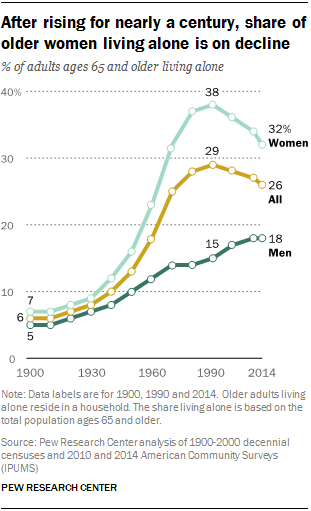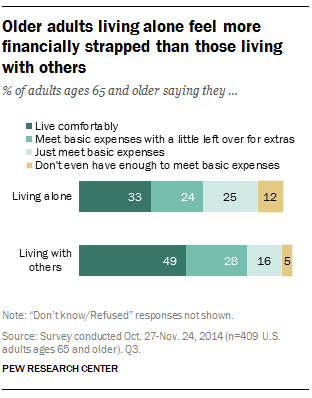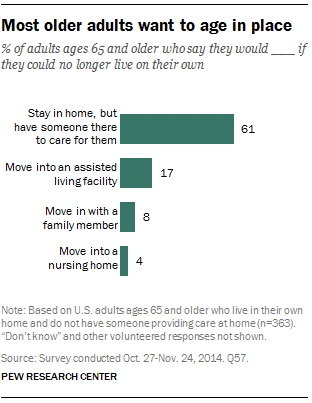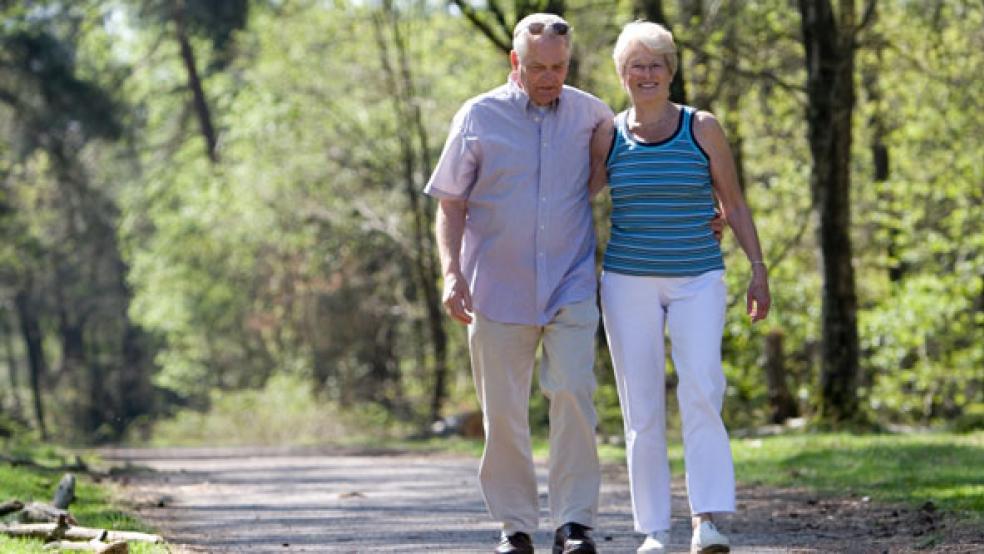There has been a subtle but important shift in the life style of older Americans in recent decades – one that punches a hole in the stereotype of the lonely unmarried woman.
Throughout much of the 20th century, the share of older Americans living alone – especially women – increased substantially, from 6 percent to 29 percent between 1900 and 1990, according to government data. Women were living longer, but in the process, they were outliving their spouses. And rather than moving to a retirement community or living with their children or friends, they remained in place.
Related: Where Will 78 Million Boomers Retire? Facing the Challenge of Aging in Place
But between 1990 and 2014, there was a significant shift, and the share of older adults who were living by themselves declined by three percentage points, to 26 percent, according to a new Pew Research analysis of U.S. Census Bureau data.
The decline in loneliness was far more pronounced among women than in men. Among older women 65 to 84, the number living alone actually fell from 38 percent to 31 percent in 2014. Among older men, the share who were living alone rose by three percentage points in that same period, from 15 percent to 18 percent.
“One explanation for this trend is that an increase in life expectancy, especially among men, has made it more likely that older women would be living with their spouses rather than as widows,” the report stated. “Older men ages 65 to 84, on the other hand, are somewhat less likely to live with a spouse now compared with 1990, though most still do.”
Related: Millions of Boomers Are Making This Big Retirement Mistake
“Living arrangements for men in this age group have grown more diverse as a rising share have divorced and not remarried,” the report added.”

Renee Stepler, a Pew researcher and author of the study, said in an interview that the decline in the share of older women living alone is part of a larger change in the life style of older Americans. Increased longevity – especially for men – is a major factor. The declining mortality rate for men from heart disease, for example, is one reason.
But aging baby boomers prefer to stay together in their homes for as long as possible before considering a move to a retirement community or nursing home. Moreover, older adults feel less financially secure and comfortable living alone than living with someone else – whether with a member of the family or just an acquaintance.
And, as Stepler found, this group is eager for social interaction and feels isolated from their families and the outside world living alone.
Related: The Worst States for Retirement in 2015
“Men who live alone are less likely than men who live with others to say they are very satisfied with the number of friends they have,” she said. “And we found that adults living alone are in less frequent contact with their children and grandchildren as well. There are some important factors there on the social life.”
John Rother, president of the National Coalition on Health Care and a former top official of AARP, said Monday, “It is true that longevity has increased quite dramatically, at least for middle class and better educated people in the United States.”
A 44-year study released last October by the American Cancer Society found that the death rates dropped by about 43 percent, while mortality rates for various ailments including strokes, heart disease and cancer, also fell. But the study cautioned that the rate of decline in death rates had slowed in the most recent period for some obesity-related illnesses, including heart disease, stroke and diabetes, according to The New York Times.

“It really comes down to lifestyle,” Rother said. “The key thing that’s changed and that’s hopeful is longevity for men. That of course contributes to couples continuing to live together and less time for usually the surviving female to be on her own.”
Related: 10 Best Cities for a Healthy Retirement
“It’s all positive, but of course the good news is outweighed by the sheer numbers of baby boomers who are now headed into their 70s,” he said. “We’re still going to have millions of older women living alone, but not as many perhaps as we thought earlier.”
Julie Gray, a senior executive with Aging Wisdom, a consulting firm in Seattle that helps families “navigate options for aging well,” said that baby boomers are demanding and getting numerous lifestyle alternatives that enable them to remain connected with their families or friends while postponing a move to an assisted living facility or nursing home.
About 78 million baby boomers are at or near retirement. Many independent-minded seniors are resisting the pressure to move to costly retirement communities or assisted living facilities and are instead making plans to stay at home.
Gray said that seniors living in the Seattle area have access to house or apartment sharing arrangements; community services that allow couples or individuals to continue to age in place, or what she called “virtue villages” where seniors live in the same neighborhood or community and help one another.
Related: Is There a Less Painful Way to Fix Social Security?
“The nice thing is that as time goes on, people are demanding a variety of options, and they’re not willing to settle for just moving into a nursing home,” Gray said in an interview. “I think that’s a function of the baby boom population. Baby boomers have always redefined how they want to live. And they certainly are an active group. They organize together. That’s why I think more and more of these virtual villages will start to pop up.”






